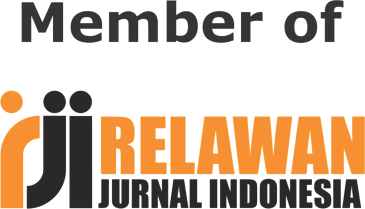Pemilihan Platform Tanda Tangan Digital Berdasarkan Faktor Keberlanjutan Selama Pandemi COVID-19 Menggunakan Metode AHP
Abstract
Sistem tanda tangan digital telah banyak dimanfaatkan terutama untuk kegiatan persetujuan dokumen selama pandemi COVID-19 di Indonesia. Penelitian ini bertujuan untuk mengetahui faktor-faktor dari dimensi sustainability yang mempengaruhi keberlanjutan dalam menggunakan sistem tanda tangan digital berdasarkan metode pendekatan AHP. Penelitian ini menggunakan metode AHP karena metode ini mampu menyelesaikan persoalan dalam suatu kerangka berpikir yang terorganisir sehingga dapat mengambil keputusan secara efektif dan akurat terhadap suatu persoalan dalam penelitian. Hasil penelitian menunjukkan bahwa sub-kriteria continuous improvement dari dimensi ekonomi menjadi prioritas utama yang menjadi penunjang dalam keberlanjutan bisnis penyedia tanda tangan digital. Selanjutnya, melakukan analisis pemilihan platform tanda tangan digital antara PrivyID, DigiSign, dan Manual Input. Berdasarkan hasil perhitungan terhadap tiga alternatif menghasilkan platform DigiSign yang paling unggul dibandingkan dengan platform PrivyID dan Manual Input. Hasil tersebut sejalan dengan komitmen dari platform DigiSign yang memberikan kemudahan bagi pengguna agar dapat memeriksa dokumen yang tertunda dengan cepat, menandatangani dokumen dengan tingkat keamanan yang tinggi dan enkripsi berstandar Internasional, serta dapat melacak status dokumen dengan mudah. Sedangkan tanda tangan elektronik yang dilakukan dengan cara Manual Input memiliki kelemahan yang sangat kritikal, dimana tanda tangan elektronik tersebut tidak terenkripsi sehingga tidak mampu untuk melindungi dokumen dari pencurian data identitas atau entitas perusahaan oleh pihak yang tidak bertanggung jawab.
Abstract
The digital signature system has been widely used, especially for document approval activities during the COVID-19 pandemic in Indonesia. This study aims to determine the factors of the sustainability dimension that affect sustainability in using a digital signature system based on the AHP approach. This study uses the AHP method because this method is able to solve problems in an organized framework so that it can take a decisions effectively and accurately on a research problem. The results of this study indicate that the sub-criteria for continuous improvement from the economic dimension is the main priority that supports the sustainability of the digital signature provider business. Furthermore, analyze the selection of digital signature platforms between PrivyID, DigiSign, and Manual Input. Based on the results of the calculation of the three alternatives, the DigiSign platform is the most superior compared to the PrivyID platform and Manual Input. This results are in line with the commitment of the DigiSign platform which makes it easy for users to quickly check pending documents, sign the documents with a high level of security and International standard encryption, and easy to tracking the document status. Meanwhile, electronic signatures made by Manual Input have a very critical weakness, where the electronic signature is not encrypted so it is unable to protect documents from theft of identity data or corporate entities by irresponsible parties.
Downloads
References
A. Alshehhi, H. Nobanee, and N. Khare, “The impact of sustainability practices on corporate financial performance: Literature trends and future research potential,” Sustainability (Switzerland), vol. 10, no. 2. 2018, doi: 10.3390/su10020494.
S. Aksin-Sivrikaya and C. B. Bhattacharya, “Where Digitalization Meets Sustainability: Opportunities and Challenges,” 2017.
F. F. Khizbullin, T. G. Sologub, S. V. Bulganina, T. E. Lebedeva, V. S. Novikov, and V. V. Prokhorova, “The direction of transformation of Information and Communication Technology (ICT) at the present stage of development into an electronic and information society,” Pertanika J. Soc. Sci. Humanit., vol. 25, no. 8, pp. 45–58, 2017.
BSSN, “Laporan Hasil Monitoring Keamanan Siber Tahun 2020,” Pusat Operasi Keamanan Siber Nasional, pp. 10–13, 2020.
I. Abdullah, “COVID-19 : Threat and Fear in Indonesia,” Am. Psychol. Assoc., pp. 488–490, 2020.
A. Antoni, “Kejahatan Dunia Maya (Cyber Crime) Dalam SIMAK Online,” Nurani J. Kaji. Syari’ah dan Masy., vol. 17, no. 2, 2018, doi: 10.19109/nurani.v17i2.1192.
D. Iskandar and Istaningsih, “The effect of safety, easy and promotion on the behavior of food e-commerce use system in the COVID-19 pandemic time,” Int. J. Manag. Stud. Soc. Sci. Res., vol. 3, no. 3, pp. 352–371, 2021.
Bank Indonesia, “Laporan Akuntabilitas Tahunan Bank Indonesia 2020,” Laporan Tahunan Bank Indonesia, 2020.
A. I. Dzhangarov and M. A. Suleymanova, “Electronic digital signature,” in IOP Conference Series: Materials Science and Engineering, 2020, vol. 862, no. 5, doi: 10.1088/1757-899X/862/5/052054.
A. A. Nugroho, A. Winanti, and A. Surahmad, “Personal Data Protection in Indonesia: Legal Perspective,” Int. J. Multicult. Multireligious Underst., vol. 7, no. 7, pp. 183–189, 2020.
M. Yusup, D. Cahvadi, E. Febriyanto, Mardiana, and F. Budiarty, “The Impact of Socio- Economic in Digital Signature Using Blockchain Application,” 2020, doi: 10.1109/CITSM50537.2020.9268893.
R. Dermawan, “Pemanfaatan Tanda Tangan Digital Tersertifikasi di Era Pandemi,” Rewang Rencang J. Huk. Lex Gen., vol. 2, no. 8, pp. 762–781, 2021.
K. W. Chong, Y. S. Kim, and J. Choi, “A study of factors affecting intention to adopt a cloud-based digital signature service,” Inf., vol. 12, no. 2, 2021, doi: 10.3390/info12020060.
L. Costaner, G. Guntoro, and F. Alfarasy, “Analisis Analitical Hierarchy Process Dalam Percepat Penyeleksian Penerimaan Tenaga Pendidik,” Digit. Zo. J. Teknol. Inf. dan Komun., vol. 12, no. 1, 2021, doi: 10.31849/digitalzone.v12i1.6614.
I. Fahmi, F. Kurnia, and G. E. . Mige, “Perancangan Sistem Promosi Jabatan Menggunakan Kombinasi Analytical Hierarchy Process (AHP) dan Profile Matching (PM),” J. SPEKTRO, vol. 2, no. 1, 2019.
A. Mauko, M. B, and P. Sugiartawan, “Sistem Pendukung Keputusan Kelompok pemilihan Saham LQ45 dengan menggunakan metode AHP, Promethee dan BORDA,” J. Sist. Inf. dan Komput. Terap. Indones., vol. 1, no. 1, 2018, doi: 10.33173/jsikti.6.
P. Diah, S. Dewi, and S. Suryati, “Penerapan Metode AHP dan SAW untuk Penentuan Kenaikan Jabatan Karyawan,” JATISI (Jurnal Tek. Inform. dan Sist. Informasi), vol. 5, no. 1, 2018, doi: 10.35957/jatisi.v5i1.130.
R. Rachman, “Penerapan Metode AHP Untuk Menentukan Kualitas Pakaian Jadi Di Industri Garment,” J. Inform., vol. 6, no. 1, 2019, doi: 10.31311/ji.v6i1.4389.
A. S. R. Sinaga, “Penentuan Karyawan Lembur Dengan Metode Analytical Hierarchy Process (AHP),” J. Inkofar, vol. 1, no. 2, 2019, doi: 10.46846/jurnalinkofar.v1i2.67.
I. Granita, “Financial Technology Di Indonesia,” J. Teknol. Inf., vol. 2, no. 1, 2020.
A. F. Kresna, “Legalitas Tanda Tangan Elektronik Pejabat Dalam Rangka Mendukung E-Government,” Humas Mahkamah Agung Republik Indonesia, 2019.
Copyright (c) 2021 Digital Zone: Jurnal Teknologi Informasi dan Komunikasi

This work is licensed under a Creative Commons Attribution-ShareAlike 4.0 International License.












